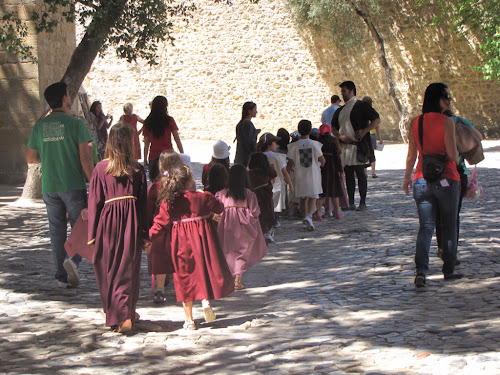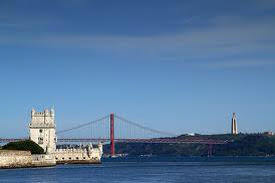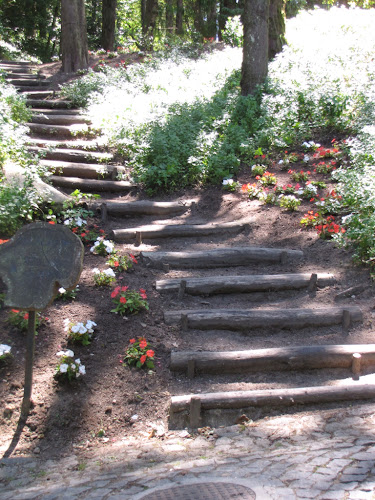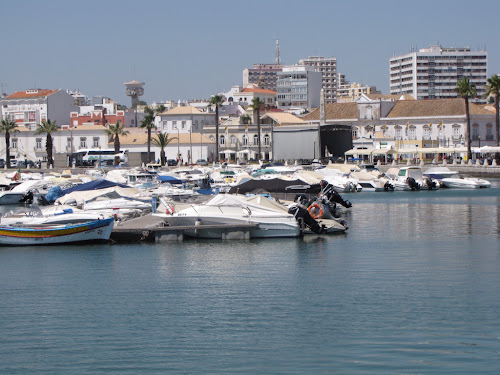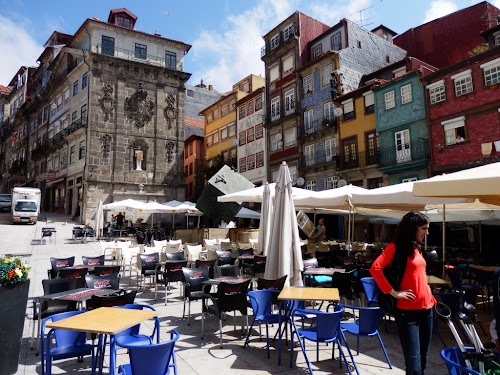Fri 21st June
Our hosts met us as arranged in the morning to check-out, then we walked the short distance to the metro and caught connections to the station where our train left for Lisbon with plenty of time to spare. Our trip was just under 3 hours with wifi in each carriage. How good is that? We crossed the Duoro for the last time and had a very pleasant journey to Lisboa. Then the fun began. It wasn't difficult finding the metro and sorting the different lines and directions but when we walked out onto the street at Martin Moniz we were baffled by the streets, many which end in steps. Lugging our bags along the busy pavements and up and down steps with frustration mounting was not a good way to end the trip. Perhaps a taxi would have been a better idea. We eventually found our way to Rua João do Outeiro 55, Lisboa and climbed upstairs to level 2 (more steps). Our bedroom is on level 3. The apartment is in a quarter known as Mouraria, right by Baixa, the heart of the old centre of town. Baixa was destroyed in the earthquake of 1755 and when the Marquis of the time rebuilt it, he laid out all the streets in a grid pattern so it is very easy to navigate. On the other hand, Mouraria is still as it was in medieval times, so a minefield to navigate
Looking out our back window.
The building dates back to the1690’s – which makes it very old even for Lisbon standards. The apartment was done-up in 2010 so has all the mod cons and a great shower but quite small. It is definitely only a one person kitchen and bathroom. There is really only one place to sit too, so not as good as our last stop but we won't be indoors that much. I'm sure the weather will improve.
Eric beside a Fado monument near Martin Moniz MRT
Once we were settled-in we ventured back out to the Praca de Figueira to meet the 2 other couples we last saw at Paris airport, they have all spent the day in Sintra. Many of the streets in the neighbourhood are decorated in hand-made paper lanterns and streamers as if for street parties.
By now the 2 other couples (Deb and Michael, Heather and Michael) are old hands at finding their way around Lisbon so have lots to share over dinner accompanied by green wine (dry white made from immature grapes) and finished with pear liqueur.
After dinner we followed the crowds to the riverfront where the boats were all lit up. On the cue of a flare they all blew their fog horns. Not sure yet of the significance but everyone cheered before dispersing. Walking home we found many street parties, everyone out celebrating with loud music and food. Being a Friday night the party is not going to quieten down for these two weary travellers so we went to sleep in our loft to the beat of party revellers. It wasn't necessarily Fado style but a mix of world music I guess, including some pop and rock. Every now and again I would know a tune but my brain was too tired to recognise it, the words being sung in Portuguese. The next morning the streets are still decorated but the rubbish is mounting. We find Lisbon quite dirty compared to Porto.
Googling for information it seems that, being the birthplace of St. Anthony, Lisbon celebrates the saint’s birth during June with a Sardine Festival. In the historical centre the street entertainment ranges from theatre to all genres of music, to circus acts and mime. We have missed the main parade where associations from the city’s different neighborhoods marched down Avenida da Liberdade competing with one another in flashy costumes to music. In the old districts (like Mouraria) the streets are alive at night with lanterns, music, and crowds. In these parties Arraiais) the people of Lisbon go to dance and eat sardines all month long.
Saturday 22nd June
The sky is blue and the sun is glorious this morning. We got a load of washing done before joining the others in an organised walk from Praca do Comercio for an overview of the main city sites. We really enjoyed Pedro's explanation of the history and development of the city and some of the quirky snippets he included. Some of the landmarks we visited included Baixa – the new city built after the earthquake, Praça da Figueira – Lisbon’s traditional market square, Rossio – the heart of Downtown, Santa Justa Iron Lift viewpoint – 360º view over the Downtown district, Largo do Carmo – the setting for the democratic revolution of 1974, Carmo ruins – the only Gothic monument of the city, Bairro Alto – the lively bohemian district and Graça Viewpoint – a stunning overview of the city and the 25th of April bridge which we arrived at after a ride on tram 28.
Statue at Praca do Comercio (Commerce Sq.) just being unveiled after restoration
Pedro sharing his local insights with us.
Fun statues in a Braixa Square on our way to the No. 28 tram.
After lunch we left the others to visit the São Jorge Castle. We found it pleasantly shady to wander around while providing fabulous views of Lisbon (including Mouraria). The entrance to the São Jorge Castle is around 600 metres from our doorstep but it is oh, so steep to decend. I am starting to get my bearings now, thanks to the morning walk.
While we were wandering around the castle we came across these students and their teachers dressed in period costume for their excursion.
At about 6pm the neighbourhood was just coming alive with music and fiesta activities and feeling refreshed after a late afternoon siesta, we followed the music to Martim Moniz Square where we caught the end of a samba set which was followed by a very popular regional brass band. The others joined us and we moved on to a restaurant just near the Largo do Carmo for our last meal together. They move on to Evora tomorrow while we still have a few more days here.
Sunday 23rd June
Woke to a sore throat and knees, need a day's rest but there is too much to see and do
We caught the yellow bus tour to Belem. The trip took us through some of the more modern areas of the city and then along the Rio Tejo (Tagus River) towards the mouth where Belem lies. We visited the Museu da Marinha which is appropriately housed in the Jeronimos Monastery since the church funded and supported the maritime exploits. The museum contains many models of 15th to 18th century sailing ships, celebrating the glory of Portuguese discovery and domination in the Age of Discovery when Europeans were searching for new trade routes via the oceans which had them explore Africa, the Americas, Asia and Oceania. It was interesting to learn about the treaty, drawn up to prevent conflict between the two most successful explorers, Portugal and Spain. When it was signed it divided the world into two regions of exploration, where each had exclusive rights to claim newly discovered lands, no matter who actually discovered it.
No trip to historic Belem is complete without visiting Antiga Confeitaria de Belem, a traditional cafe renowned for its custard tart recipe. If you can drag your eyes away from the array of pastries on display you can also admire the tiled walls of the interior.
The drive home took us along the Tagus River and passed the 25th April Bridge. It was originally named after dictator Salazar, but its name was changed after the revolution of April 25, 1974 when the fascists were defeated. Over 3 kms long, it is often compared to San Fransisco's Golden Gate Bridge which it resembles in both structure and colour.Near the far end of the bridge is an imposing monument to Christ inspired by the famous statue in Rio de Janeiro. It was built in 1959 in thanks to God for having spared Portugal during WWII when they remained neutral.
Mon 24th June
We had a pretty lazy start to the day and then caught the train to gorgeous Sintra, reputed to be the single most beautiful town in all of Portugal. The train only takes about 45 mins from Lisboa and we spent the entire day wandering about in its quaint streets, beautiful cool gardens and visiting two major attractions; Castelo Mouros and Palácio Nacional de Pena. There are 2 other palaces here as well but you can only do so much in one day! The Moorish Castle is thought to have been constructed in the eighth or ninth century at the height of the Moorish occupation. The castle walls wind their way up the mountain to the summit, merging with the jagged rocks that line the steep gradients. The views extend right across the forested hills to the Atlantic so a very strategic place to build such a fortress. We could see Lisbon's 25th April Bridge from here. We also had fabulous views looking towards the Pena Palace.
The Pena Palace, coloured sand and pastel colours, is said to be one of the world’s best examples of Romantic architecture from the nineteenth century. Perched high on Sintra Mountain overlooking the town, its onion shaped domes and tall clock tower are one of Portugal's best known images. It is a protected national monument, both a UNESCO World Heritage site and one of the official Seven Wonders of Portugal. It now also rates as my favourite palace; opulent no doubt but charming rather than audacious. The gardens cover a huge expanse but they are mostly pockets woven into the natural, shady forest.
Our last night in Lisboa. Although we are both very tired we ventured back down to Largo de São Domingos, a colourful Square with a colourful past for dinner. Depending on your faith, the church on the square is either blessed or cursed having survived fires and earthquakes. The square is also the site of a bloody massacre of Jews in the 1500's when they were accused of being heretics as well as responsible for the drought. It may have had more to do with the fact that they were the financiers of the day though. These days the African community clusters in the area because this church has had a black priest. We had fish for dinner, it is the traditional dish after all. Locals certainly love the salted cod, but I find it too salty. We resisted the offer of a glass of ginginha, a local syrupy cherry brandy liqueur as a nightcap. Tonight the music is definitely of African origin.
Tuesday 25th June
After tidying up and packing we were in plenty of time to catch the train to Faro from Oriente Station. The journey took us across the 25th April Bridge and on through townships, olive groves and orchards of citrus and fig. We didn't see any cherry trees but they must be around somewhere as the shops are all selling them. Three and a half hours later and at the end of the line, we were in Faro on the Algarve, Portugal's sunniest spot with the finest beaches and weather on the continent according to the brochures. True, the weather is glorious. Haven't found the beaches yet, perhaps they are further out of town. Faro is the provincial capital and not a resort town like the other centres. We booked our onward bus tickets to Seville for tomorrow morning and then spent the afternoon wandering by the marina to the old walled town with its quiet, cobbled streets and buildings that date back to the 16th century. Offshore there are many islands and islets. The region also includes a lagoon and nature reserve which are significant migratory birding sites. It reminds us a lot of the Camargue region in Southern France.








